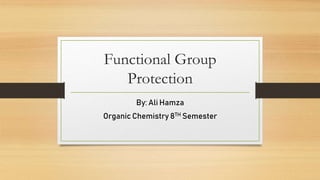
Introduction to Functional Group Protection.pptx
- 1. Functional Group Protection By: Ali Hamza Organic Chemistry 8TH Semester
- 2. Functional groups are crucial components of organic molecules, dictating their reactivity and properties. Protection of functional groups involves shielding them from undesired reactions during synthetic processes. Example: Protecting the hydroxyl group in alcohols using a silyl ether, such as trimethylsilyl ether (TMS), to prevent unwanted reactions during subsequent transformations. Strategies for Functional Group Protection Several strategies are employed to protect functional groups, ensuring selective reactions and control over synthetic pathways. Example: Utilizing acetals or ketals to shield carbonyl groups in aldehydes and ketones, allowing for the selective manipulation of other functional groups.
- 3. Strategies for Functional Group Protection In organic synthesis, various strategies are employed to protect functional groups, ensuring selective reactions and control over synthetic pathways. These strategies are vital for preventing undesired reactions and facilitating the manipulation of specific functional groups while leaving others intact. Let's delve into some common strategies: 1.Reversible Protection: 1. Reversible protection involves the use of protecting groups that can be easily installed and removed under specific conditions. 2. These protecting groups undergo controlled reactions to shield the functional group temporarily, allowing for subsequent transformations. 3. Examples include acetal and ketal formation to protect carbonyl groups, and silyl ether formation to protect hydroxyl groups. 2.Masking Reagents: 1. Masking reagents selectively react with certain functional groups, rendering them temporarily inert to other reactions. 2. Chemoselective reagents are utilized to mask specific functional groups while leaving others unaffected. 3. For instance, Boc (tert-butyloxycarbonyl) and Fmoc (fluorenylmethyloxycarbonyl) groups are commonly used to protect amines in peptide synthesis.
- 4. 1.Temporary Derivatization: 1. Temporary derivatization involves converting functional groups into less reactive forms through reversible transformations. 2. By altering the chemical environment around the functional group, its reactivity can be modulated, allowing for selective reactions. 3. This strategy is particularly useful for protecting groups that are sensitive to reaction conditions or prone to undesired reactions. Each of these strategies offers distinct advantages and is chosen based on the specific requirements of the synthesis. Common Protecting Groups and Applications Various protecting groups find applications in organic synthesis, each offering unique advantages in specific contexts. Example: Boc (tert-butyloxycarbonyl) group protecting the amine functionality in peptide synthesis, enabling stepwise assembly of amino acids into polypeptide chains. Deprotection of Functional Groups Deprotection involves the selective removal of protecting groups once the desired synthetic steps are completed, restoring the original functionality. Example: Deprotection of a benzyl ether using hydrogenation, regenerating the hydroxyl group under mild conditions without affecting other functional groups.
- 5. Applications in Organic Synthesis Protection and deprotection strategies play pivotal roles in various applications in organic synthesis, enabling the construction of complex molecules with precision. Example: Total synthesis of natural products, such as taxol, relies on protection and deprotection steps to control reactivity and achieve selective transformations, leading to the efficient construction of complex molecular frameworks. Conclusion: Protection and deprotection of functional groups are indispensable techniques in organic synthesis, providing chemists with powerful tools to achieve precise control over molecular structures and reactions.
- 6. Total Synthesis of Natural Products: 1. Protection and deprotection steps are integral to the total synthesis of natural products, such as complex secondary metabolites and pharmaceuticals. 2. These molecules often possess intricate structures with multiple functional groups, necessitating precise control over synthetic transformations. 3. By strategically protecting reactive functional groups, chemists can manipulate molecular architecture and achieve selective bond formations. 4. Total synthesis endeavors, such as those targeting complex molecules like taxol or morphine, heavily rely on protection and deprotection strategies to control reactivity and stereochemistry, ultimately enabling the efficient construction of target molecules. Medicinal Chemistry: 1. Protection and deprotection play vital roles in medicinal chemistry, particularly in the synthesis of pharmaceutical compounds. 2. Pharmaceutical molecules often contain functional groups that require protection to prevent unwanted side reactions during synthesis. 3. By employing suitable protecting groups, medicinal chemists can optimize synthetic routes, enhance yields, and improve the purity of drug candidates. 4. Protection and deprotection strategies enable the modification of drug molecules to enhance potency, selectivity, and pharmacokinetic properties, contributing to the development of novel therapeutics.
- 7. Materials Science: 1. Protection and deprotection techniques are utilized in materials science for the synthesis of advanced materials with tailored properties. 2. Polymer synthesis, in particular, relies on protection strategies to control chain growth and end- group functionality. 3. Functional groups in polymers are often protected to prevent premature termination or side reactions, allowing for precise control over polymer architecture and properties. 4. Protection and deprotection methods enable the incorporation of functional groups into polymer chains, facilitating the design of materials with specific mechanical, optical, or electronic properties. Chemical Biology: 1. In chemical biology, protection and deprotection strategies are employed to modify biomolecules for various applications, including drug discovery and molecular imaging. 2. Protecting groups are used to modify amino acids, sugars, and nucleotides in peptides, oligonucleotides, and glycoconjugates, enabling the study of biological processes and the development of bioactive compounds. 3. Deprotection of biomolecular conjugates allows for the controlled release of bioactive molecules in targeted locations or under specific physiological conditions, enhancing therapeutic efficacy and minimizing off-target effects.